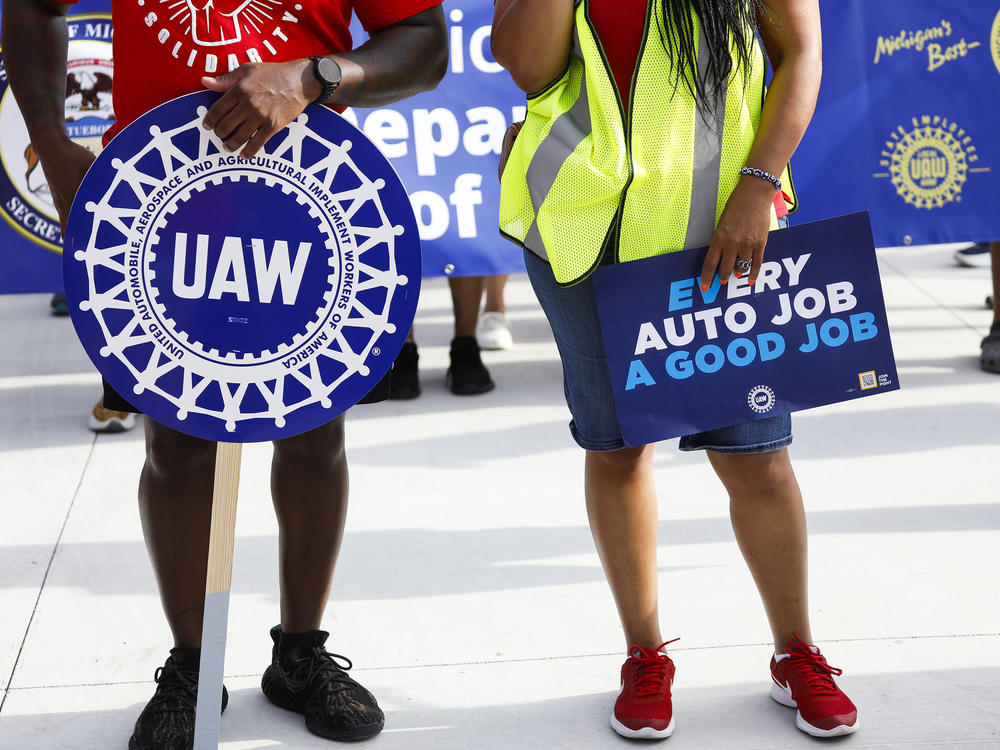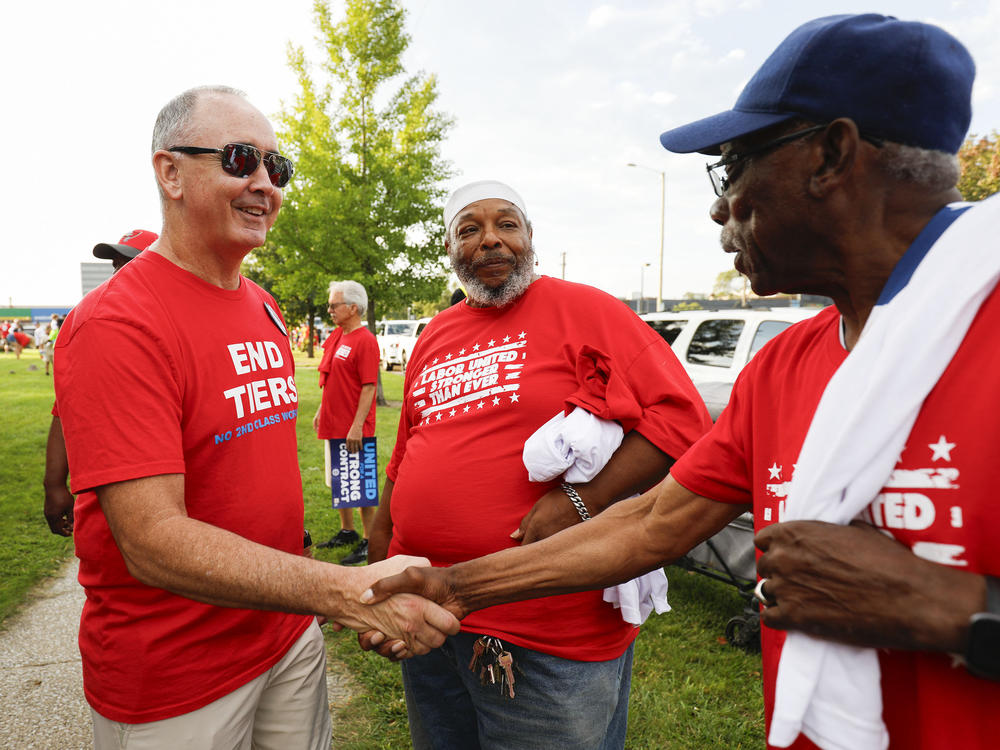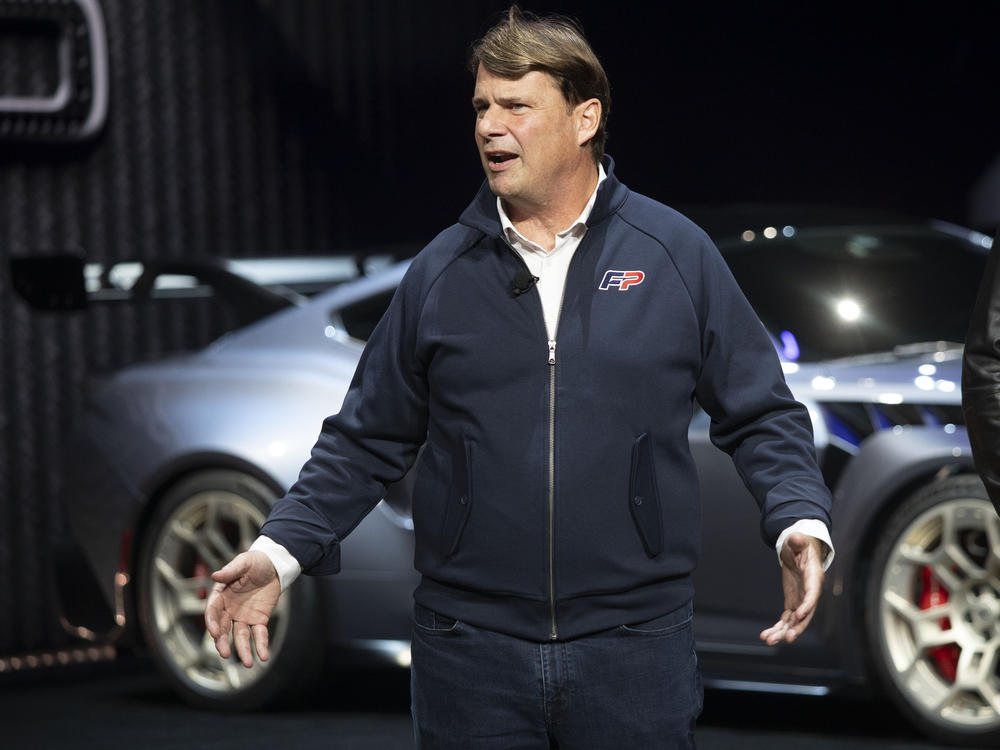Section Branding
Header Content
Here's where things stand just before the UAW and Big 3 automakers' contract deadline
Primary Content
With less than 24 hours left before current strikes expire, the United Auto Workers' union and the Detroit Big 3 automakers have not yet reached a deal.
The companies say it's still possible to work out a viable compromise before 11:59 p.m. on Thursday. The union, meanwhile, has started laying out its strike plan – an unusual one, at that.
Here's what you need to know as the final day of talks kicks off.
For now, the two sides still stand far apart
For now, the two sides have yet to clinch a deal — and there seems to be plenty of anger all around.
The union, pointing to soaring profits, says companies can afford more
In a Facebook Live event on Wednesday night, UAW president Shawn Fain put up a chart comparing Big 3 profits – up 65% over four years – to autoworker pay, which increased just 6%.
He said while what the automakers are offering in response to union demands has improved, it still doesn't reflect the sacrifices of the autoworkers that made the companies' success possible.
"They could double our wages and not raise car prices and still make billions of dollars in profit," he said. "They want to scare the American people into thinking the autoworkers are the problem. We're not the problem. ... Corporate greed is the problem. And come tomorrow night, if they force us, we're about to make it the Big Three's problem."
The UAW plans to strike in an unprecedented way
The UAW says it's ready to strike as soon as the contract expires just before midnight on Thursday.
But the strike will be different this time.
To begin with, the UAW has conducted these talks in an unusual way. Typically it picks one company to hash out a deal with, possibly striking against them, and then once that's resolved, it pushes the other two companies to more or less match that deal.
This time, it threatened to strike all three at once if they didn't each make a satisfactory offer. The union also provided regular updates about what both sides had offered, atypical for a process often shrouded in secrecy.
Now the union has outlined a strike plan that would be as unusual as the talks. "We're inventing a whole new way to strike," Fain said in his Wednesday live-stream. He called it the "stand-up strike," a reference to the "sit-down strikes" of 1937.
Instead of walking out en masse, the UAW is planning to strike at a small number of plants to start with – at one, two or all three companies, depending on whether any tentative deals are struck.
But if they're not satisfied with how bargaining is moving, the UAW will add more and more strike locations.
A tentative deal might not be the end of the story
A last-minute deal is entirely possible, with one or more of the companies. But any deal struck by the union leadership still has be ratified by the membership as a whole, and workers could choose to send their leaders back to the table to push for more.
In 2021, workers at John Deere rejected two tentative agreements before finally approving a better deal.
Some in the auto industry have wondered if the UAW's militant tone and emphasis on the power of strikes would make it harder to get any initial deal ratified this year. Even with a decent offer on the table, workers might suspect they could get better terms after striking.
Ford says the UAW hasn't been offering counter-proposals
That's all very hypothetical for now, because there's no sign of a deal.
Normally, over the course of a negotiation, two sides start far apart and trade offers to work toward somewhere in the middle. At least one company says the union isn't holding up its side.
Ford CEO Jim Farley, with clear frustration, said his company had presented four increasingly generous offers without any substantive counter proposal from the union.
"In fact, the first time I even found out that Shawn Fain had seen our [latest] offer was tonight on Facebook Live," Farley told reporters at the Detroit Auto Show on Wednesday. "We're here. We're ready to negotiate. But it's sure hard to negotiate a contract when there's no one to negotiate with."
"We want to make a deal," he said. "If there is a strike, it won't be because we didn't put a great deal in front of them, because we have – four times."
In statements on Wednesday, GM simply said it was continuing to bargain "directly and in good faith" with the union. But Stellantis said it was still waiting on a counter proposal to the offer it made on Tuesday.
On pay and cost of living, the automakers have shifted
The union initially asked for a pay increase of more than 40%, citing a 40% increase in CEO pay over the last four years. They also pushed for a return of cost-of-living adjustments, or COLA, which are pay increases pegged to inflation – an issue close to workers' hearts right now, after experiencing high inflation that reduced the value of their wages.
Meanwhile, companies have raised their offers on wages, going from 9 or 10% initially to as high as 20% now, but the union says that's still barely enough to make up for inflation and previous stagnant pay.
The companies also have shifted from offering one-time "inflation bonuses" – which companies prefer over pay increases, because they don't accumulate over time – to offering COLA, albeit at levels the union says are inadequate.
In addition to wages, unionized auto workers get profit-sharing checks. The UAW wants to tie the size of those checks to the amount the companies spend on stock buybacks and dividends, but says companies want to calculate that in such a way as to make checks smaller.
Little progress on hours, work-life balance
The union had been pushing for reductions in hours - including, notably, an argument for a 4-day workweek.
The companies are agreeing to make Juneteenth a holiday, and Ford has offered 2 weeks of parental leave, but otherwise, there has been no major movement on paid time off.
On tiers, the two sides disagree on where they stand
Ford says that it has agreed to totally eliminate pay tiers. The union says Ford has made no such offer. The reason? The two sides simply don't agree on what a tier is.
In 2007, during difficult talks while auto companies were financially struggling, the union accepted a deal it came to regret: to preserve higher pay for its existing members, it allowed lower pay for new hires. That created a two-tier system that led to resentment and frustration within the union.
Back then, a "second-tier' employee would never earn as much as a "first-tier" one. But that changed in 2019. Now a new hire can work their way up to the same pay as their colleagues, over the course of eight years.
The companies do not consider this a "tier" system, since the pay is eventually equal, and they're offering to reduce the timeline to bridge the gap to four years. But the union views the requirement to work for years before getting maximum wages – along with the fact that people hired since 2007 don't get pensions or retiree benefits – as a form of a "tier."
On job security, retiree benefits and pensions, the sides remain far apart
On pensions and benefits for retired workers, the companies have not budged. Automakers say pensions and retirement benefits are simply too expensive; they also make the case that some workers prefer 401(k)s to pensions, because they can be taken with you if you change jobs. The union has expressed a strong preference for the guaranteed payments of a pension.
The union has also been pushing for another benefit that's a blast from the past: job security guarantees that would continue to pay workers even if a plant is shut down. That, too, has gotten no traction. A similar program to pay workers not to work was an infamous burden on automakers up until the late 2000s, and hurt the public reputation of the union.
Copyright 2023 NPR. To see more, visit https://www.npr.org.



